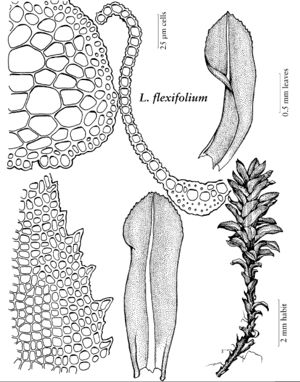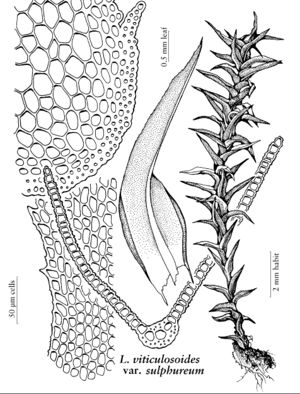Leptodontium
Öfvers. Kongl. Vetensk.-Akad. Förh. 21: 227. 1864 ,.
| Taxon | Illustrator ⠉ | |
|---|---|---|
 | Leptodontium flexifolium | Patricia M. Eckel |
 | Leptodontium viticulosoides var. sulphureum | Patricia M. Eckel |
Plants often robust, in thick mats or short turf, yellow to orangebrown distally, yellow to redbrown proximally. Stems commonly elongate, 1–5 cm; hyalodermis absent [present and usually collapsed when mature], sclerodermis of thick-walled cells present, central strand absent; axillary hairs of 6–16 cells, cells often bulging, all clear or proximal 1–2 brownish. Leaves often widely spreading to squarrose, twisted to contorted when dry, spreading to squarrose-recurved when moist; ovate to longlanceolate, occasionally lingulate or oblong, adaxial surface keeled or channeled along costa, mostly 2–5 mm, but often longer; base usually rectangular, sheathing, proximal margins sometimes long-decurrent; distal margins recurved in proximal 1/3–3/4, usually dentate in distal 1/3–1/2, apex acute, occasionally rounded or narrowly obtuse; costa shortly excurrent, percurrent or ending 1–6 (–15) cells before apex, adaxial outgrowths absent, adaxial cells elongate, in 3–5 rows; transverse-section reniform or occasionally elliptic or semicircular, adaxial epidermis absent, adaxial stereid band present, guide cells 2–4 in 1 layer, hydroid strand absent, abaxial stereid band present, crescent-shaped in section, abaxial epidermis absent or seldom present; proximal cells differentiated medially or across base, often sharply demarcated and hyaline, rectangular, slightly wider than distal cells, 2–5: 1, walls of proximal cells thin to evenly or laterally thick-walled, occasionally porose distal medial cells subquadrate, mostly 11–15 µm wide, 1: 1, 1-stratose; papillae simple, 2-fid, or multifid, often hollow (cup or C-shaped), occasionally. columnar, cell-walls thin or evenly to collenchymatously thickened, often trigonous, often strongly bulging. [Specialized asexual reproduction by gemmae, multicellular, clavate to obovate, borne on short stalks in leaf-axils, occasionally on leaf apices or branchlets.] Sexual condition usually dioicous, rarely autoicous or possibly rhizautoicous. Perichaetia terminal, interior leaves strongly convolute-sheathing, longlanceolate, usually much longer than the cauline leaves, laminal cells long-rhomboid, porose or thin-walled. [Seta to 3 cm. Capsule stegocarpous, theca cylindric, 2.0–3.5 mm, annulus often highly differentiated, of 2–7 rows of yellowish or reddish vesiculose cells, irregularly deciduous; operculum conic to conic-rostrate; peristome teeth 16, linear, occasionally rudimentary, straight. Calyptra cucullate. Spores small.] KOH laminal color reaction usually yellow, often orange to yellowish orange, occasionally with red blotches above.
Distribution
Worldwide, mostly tropical in distribution
Discussion
Species 39 (2 in the flora).
Both species of Leptodontium in the flora area are found in moist, high-elevation sites in the southern Appalachians, while one is also in the Southwest. The major characteristics of the genus are the large annulus, highly differentiated perichaetial leaves, cauline leaves often reflexed or squarrose above a broadened, sheathing base, and the absence of stem central strand and of leaf hydroid strand and adaxial costal epidermis. Stem hyalodermis and sporophytes are absent in the two species of the flora area.
Selected References
Lower Taxa
Key
| 1 | Plants small, on soil or rock; stems short, 1-3 cm; leaves ligulate to oblong-lanceolate, bordered by 2-3 rows of less papillose, more thick-walled cells. | Leptodontium flexifolium |
| 1 | Plants larger, arboreal; stems longer, usually 5-10 cm; leaves long-lanceolate, not bordered | Leptodontium viticulosoides |